Hello! I’m thrilled to be a new contributor here on Picture Book Builders, a blog I’ve admired for a long time. A little about me: I write both fiction and nonfiction picture books, as well as middle grade novels. I’m a science geek who used to be an environmental consultant, helping to clean up hazardous waste sites. Now I write full-time, mostly about culture, identity, and food. Especially food. My most recent PB, WATERCRESS, came out in March 2021 and is a semi-autobiographical story about a Chinese American girl whose immigrant parents make her pick watercress by the side of the road.
To celebrate Pride Month, I’m excited to feature WERE I NOT A GIRL: THE INSPIRING AND TRUE STORY OF DR. JAMES BARRY, written by Lisa Robinson and illustrated by Lauren Simkin Berke.
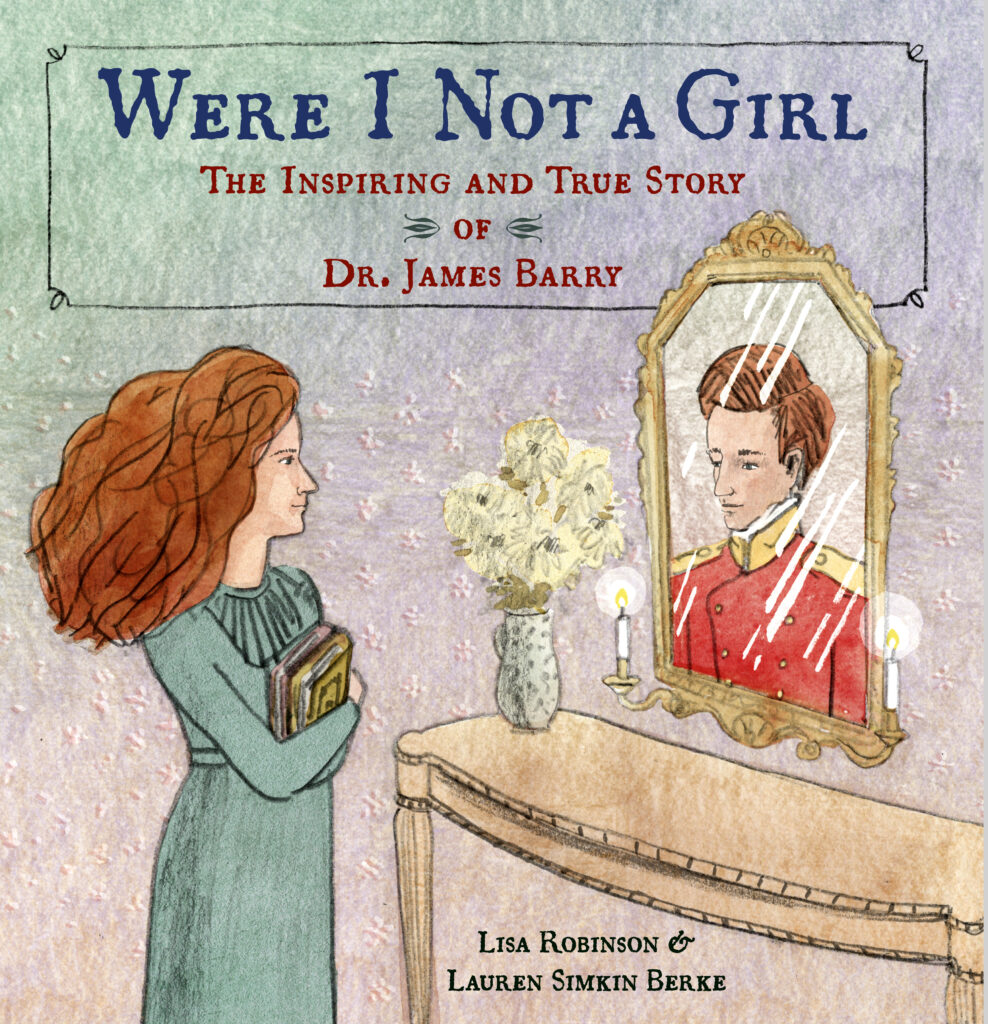
Here’s the flap copy:
“Can you imagine not being allowed to live your life as the person you feel you really are inside? Not being able to be yourself? This is a story about someone who refused to let that happen. This is the true story of Dr. James Barry.”
Lisa and Lauren were kind enough to join me for an interview. I’m always curious about the research and information that goes into a nonfiction picture book, so most of my questions are about that aspect. Welcome, Lisa and Lauren!
Lisa, early in the book, you introduce the idea that there is a lot about James that is unknown. How did you decide to deal with these gaps in his life story? What made you persevere with the story despite the lack of information?
There is actually a lot of information about James’ life; however, the gaps I encountered concerned details that felt important for telling this particular story of his life. But then, when my editor suggested using an intrusive narrator in the book, I realized that I could use this technique to discuss the gaps with the reader. And that this strategy could also provoke a discussion of how hard it is to research and tell some stories.
I persevered because it seemed like an important story to tell and I didn’t want to give up on telling it to young readers.
Lauren, I love the book cover – it conveys so much about James and his dreams, as well as the time period and the setting. Was this the first version of the cover that you drew? How did you decide on the composition of this one?
I think it is safe to say the cover illustration was very much a collaboration between myself and Rachael Cole, the art director. The ideas that made sense to me, as I presented in my initial few rounds of sketches , were not thought to be the best option to market the book to a wide audience. I drew somewhere between 30 and 40 sketches for the cover before it was approved to go to final art. The last 8-10 of these were fine tuning the initial sketch that led to the final.
Wow, 30 to 40 sketches just for the cover! No wonder the final so perfectly encompasses James’ story. James was born in Ireland, grew up in London for a time, went to medical school in Scotland, and then traveled to multiple countries. Lisa, how difficult was it to research the life of someone who lived in so many places – none of them the U.S.? What are some of the sources you used, or do you have advice for writers trying to do the same thing?
I began by reading a well sourced biography of James’ life to give me a sense of the scope of the project. Then I searched for primary sources to confirm what I had learned. The availability of information on the internet these days—including newspapers and journals from the 1800s—makes research so much more accessible, even internationally. Lauren actually obtained my most favorite piece of information about James’ life—a copy of the letter that included the phrase that became part of the book’s title: “Were I not a girl I would be a soldier!” Lauren found it in Yale’s Beinecke Rare Book Library.
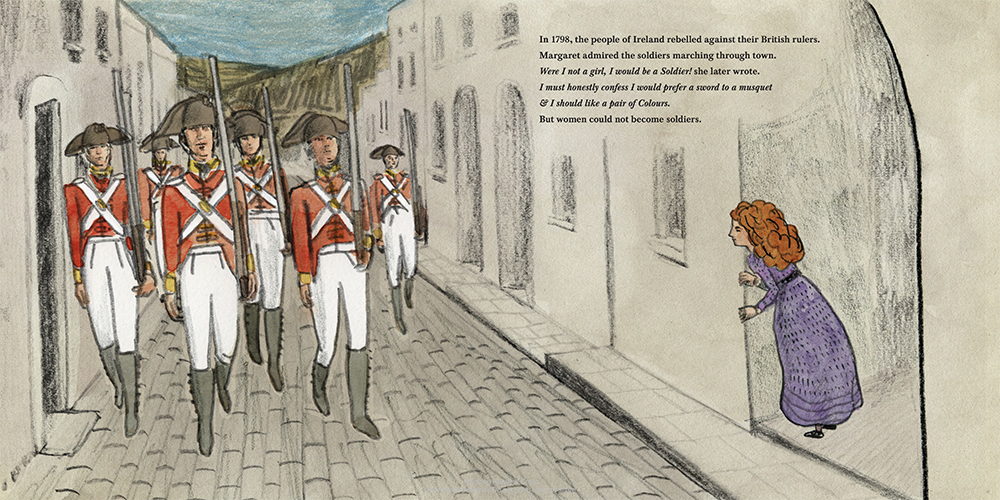
That’s incredible that you were both able to see a copy of James’ letter, and how cool that it gave your your title! On the illustration side, how much research did you have to do to portray all these different settings, Lauren? Did you find the architecture and furnishings of Ireland, England, and Scotland to be fairly similar?
I did a lot of research… on James’s life as a whole, the places he lived and worked, specific buildings and landmarks either mentioned or implied in the text, and both civilian and military dress. I did general research on Late Georgian interiors, which was relevant to the pages set in Cork and London. The settings in the book also include Edinburgh, Cape Town, and Montreal (though he lived in many more places than that). The architecture represented are real places, so I was hunting for records of what those places were like at the time James was there. I spent a lot of time hunting down what Middlesex Hospital looked like in the years James was in London as a teenager. It took a while to figure out where the medical school was physically located within the University of Edinburgh during the time James was in attendance (It turns out it was in a building referred to as “Old College”). I have spent time in Ireland (though not Cork in particular), as well as London, Edinburgh, and Montreal, which I think was helpful. I spent time watching videos set in Cape Town in order to get more familiar with the geography and landscape.
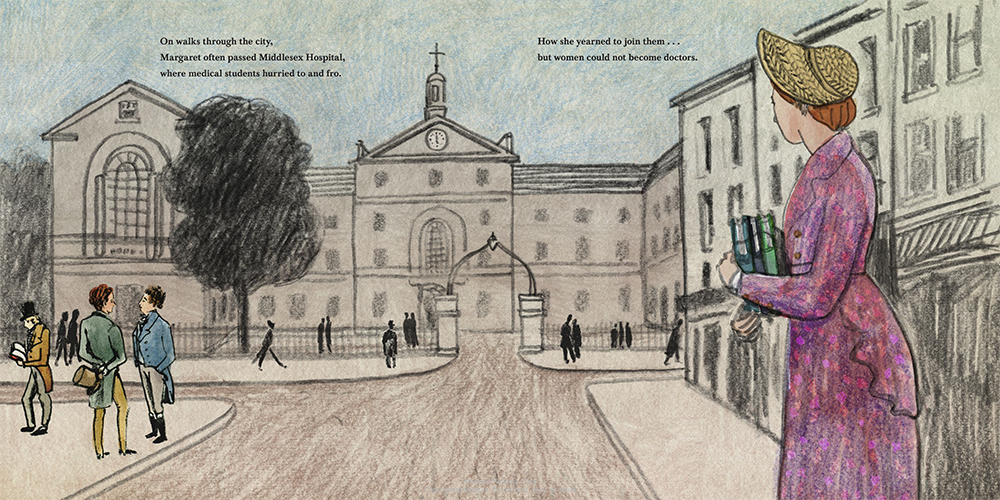
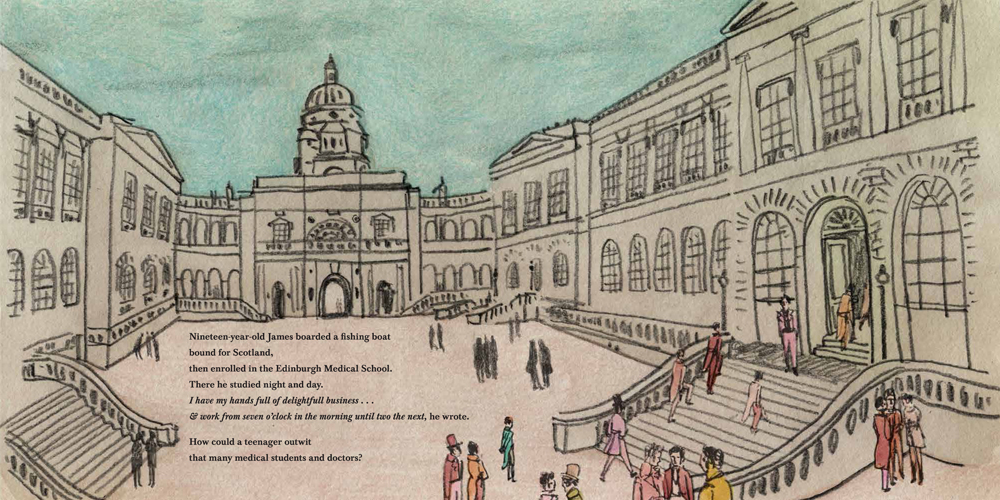
Lisa, I understand that James never wrote specifically about his gender identity. From your Author’s Note, it seems like the terms “gender identity” and “transgender” were not in use during James’ lifetime. How did you piece together your understanding of his feelings about his gender?
Lisa: Yes, those are modern terms. What I was able to understand about James Barry’s gender identity was that James identified as a man and lived his life as a man for over fifty years. He had been assigned female at birth with the name Margaret Bulkley. Those who have researched James Barry’s life have not been able to discover any personal writings about how he felt about this aspect of his identity. So I decided that I would present the facts in a straightforward manner. He clearly possessed a lot of courage given the severe constraints on gender expression at this time.
Lauren: I am going to put an answer here, even though I was not asked. There is no way to know precisely how James thought about his gender, but there are several things that make it seem highly likely that were he alive today that he would identify as trans. There is no indication that James ever presented as a woman after his transition, and he asked specifically that upon his death that he not be undressed. This wish was not honored, and led to a public outing which I presume was the reason for the request in the first place. These do not reflect the behaviors I associate with a cisgender female person living as male for the sole purpose of being able to have the occupation of their choice, which has been the way James has been presented in most tellings of his life. I can accept the ambiguity of not knowing how James would articulate his feelings about his gender, but I have the sense that those who are attached to the idea of him being a woman are not comfortable with the same level of ambiguity, and that is a problem.
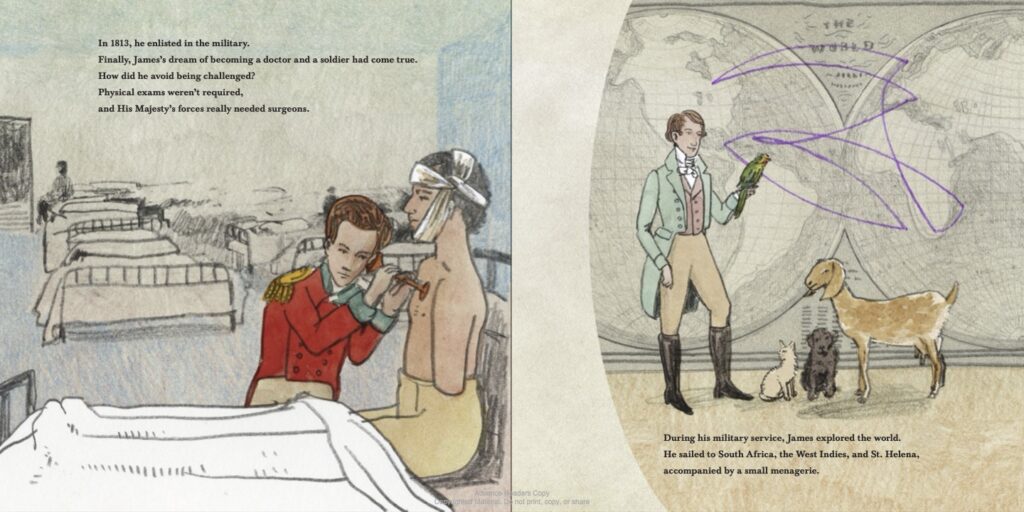
The book states that James “loved elegant fashion” and there are many different, beautiful outfits that he wears throughout the book in addition to his military uniform. Lauren, how did you approach this research, and did you draw upon any resources at the Fashion Institute of Technology where you teach?
I did what online sleuthing was possible, but most of my research was done in the Rare Books and Manuscripts Division of the main branch of the New York Public Library. The trickiest part of clothing research was determining what British Army units would have been in Cork in 1798, in order to determine the uniform colors to use in the spread set in that year. After exhausting all the resources I could find on my own, I ended up contacting the Military History Society of Ireland, and the Military History Society of England, which led to the needed information. I started the research for this book in the summer of 2018, and was working on the final art the summer and fall of 2019, finishing up a few months before I started teaching at FIT. Had I been teaching at FIT during the process of making this book, I certainly would have utilized the resources available as part of my research process.
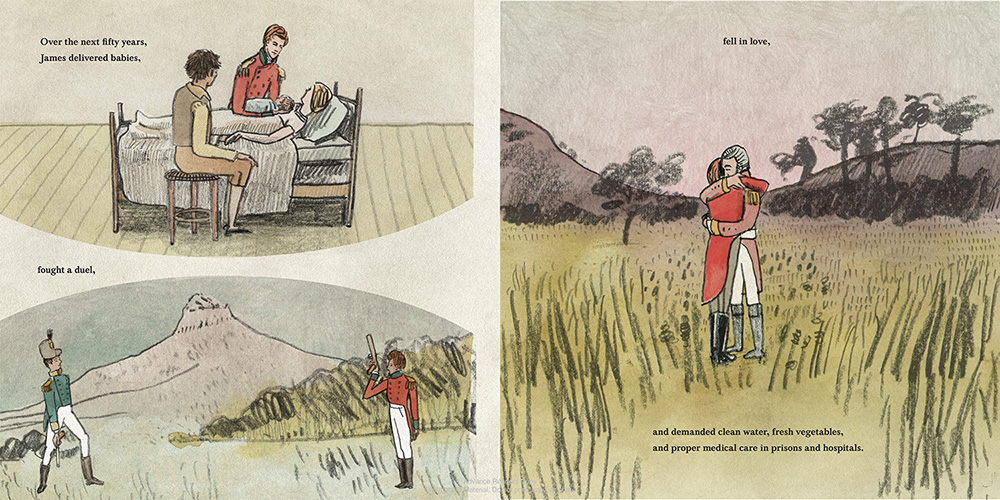
That’s great that you were able to contact societies devoted to military history. I’m always amazed by the number of groups that are dedicated to somewhat niche subjects or have documented obscure information.
I found the last line of the book, “Still, one answer was clear: James was living his truth” to be especially poignant. Lisa, how did this line come to you? Was it early or late in the writing process?
This question elicits a response I feel many writers will understand: “It takes a village. . .” I cannot take full responsibility for that line as it arose within the context of a critique group discussion about the text. When it came up, I thought: “Yes! That’s it! That’s what this book is about.” I’m super appreciative of all the people who helped make this book happen—from my critique groups to my sensitivity readers to my editor, Lauren, the art design team . . . the list goes on . . .

Lauren, what was it like to illustrate the transition and life of a transgender person in a picture book for young readers? What do you feel was important to convey in your art?
It is challenging to be the only trans person who is part of a project that tells the life of another trans person, particularly someone who lived in another time and place. The challenges are varied, but most often come down to one’s ability to parse one’s own feelings, be able to explain how elements involved relate to one’s personal experience, as well as how certain things will be translated by a contemporary lens.
I believe it is essential that the lives of trans people are told, in ways that are available to people of all ages, but for young readers in particular, in order to push back against the fictional narrative that transness is newly invented. This is not an abstract need, this is truly a matter of life and death.
The goal of my illustration work is most generally to tap into the experiential memory of the viewer, with attention towards gesture and perspective. In editorial work my illustrations often function as an introduction or advertisement for a text, to draw the reader in. When presenting work set in a particular place and time my goal is to be as accurate as possible. I want to be specific in as simplified a manner as I can, allowing space for the viewer to enter the image, and bring what they will to it.
Thank you both so much for joining me on the blog today and sharing your processes and thoughts! The amount of research and care you both put into the book is impressive, and I’m so glad the book exists as a mirror for trans kids to see themselves represented and as a window for other readers to see that trans people are part of our history.
GIVEAWAY: I’m giving away a copy of WERE I NOT A GIRL: THE INSPIRING AND TRUE STORY OF DR. JAMES BARRY to one lucky person. Just leave a comment below by June 30th and I’ll randomly pick a winner.

Lisa Robinson is a physician and the author of Madame Saqui: Revolutionary Rope Dancer, as well as Pirates Don’t Go to Kindergarten! and Pippa’s Night Parade. She has lived in cities all over the world, including Seattle, Dakar, London, and Moscow. She and her family now call Massachusetts home. Learn more about Lisa at author-lisa-robinson.com.
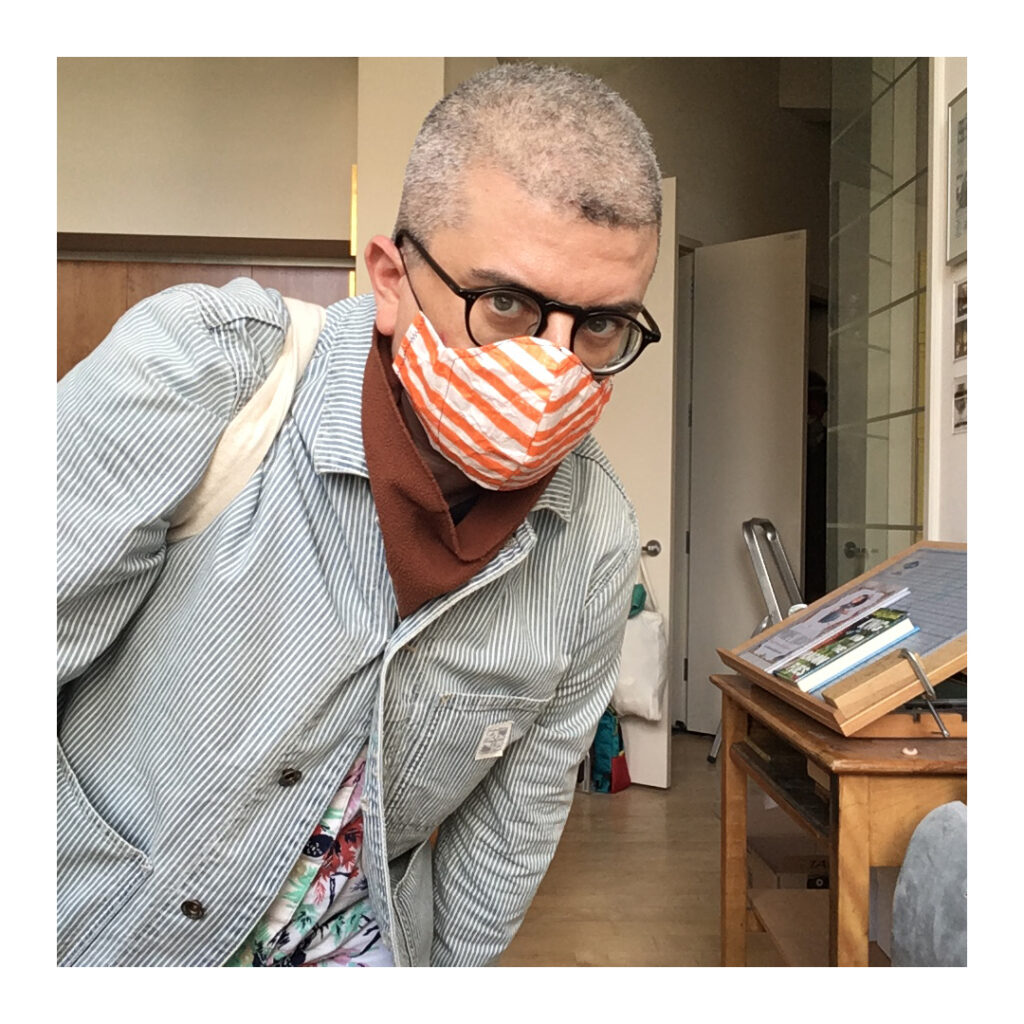

I can only imagine the deep research dives here, Lisa and Lauren! Sounds FASCINATING!!
And WELCOME, Andrea!
Hi Andrea! Thanks for a very detailed insight into a really interesting book. I so enjoyed hearing from both the author and illustrator.
Oh wow, my boy/girl twins would really love this book!
I was just reading about James Barry this week.
The illustrations look beautiful as well!
I loved learning about both your processes in your research. This book sounds fantastic and I can’t wait to read it.
Wow, what a wonderful behind-the-scenes look at the creation of this book! Thanks for sharing, Lisa and Lauren! Great interview, Andrea!
What a beautiful, beautiful story! Thank you, Lisa and Lauren for giving it the dignity and care it deserves.
Welcome, Lisa! I look forward to hearing more from you. Congrats, Lisa and Lauren! I love reading about the research process.
Great interview, Andrea! This one is going on my TBR list pronto!
Such an insightful interview! I don’t think readers appreciate how much research goes into both the text and the illustrations of a picture book biography. But seeing the spreads shared her, it seems well worth it! Can’t wait to read it!
Thank you for this insightful interview. I am impressed by the extensive research from both artists. This book is so important and I can’t wait to read and learn and share.
I’m delighted to learn about this book. With books like this, today’s kids will grow up with more empathy and understanding than kids of past generations.
Thanks for bringing light to the history of trans people.
Wow, so much information about your research and process is very helpful.
Thank you.
Fascinating! Looking forward to reading this book! Congrats, Lisa and Lauren!
I love how this book came together! Looking forward to getting my hands on a copy.
FASCINATING! Love the illustrations!!
Hi Andrea. Thanks so much for sharing such an outstanding mentor text. Congratulations, Lisa and Lauren!
I am so excited to read this book and share it with my children! This is such an important and beautiful book. I loved reading about your research and creative processes.
Great post! Welcome to PBB, Andrea!!
As a medical student I hope my niece and nephew love this book!
I have read about Barry’s life and wondered when there’d be a PB biography. Congratulations Lisa and Lauren!!! Excellent interview Andrea. Thank you.
I do find it interesting that there are several such stories about women wanting to live as a man would given how many areas were closed to women in prior ages. Even I wanted to be a boy growing up. I’ve not seen the opposite, men wanting to live like a woman until recently. So I am a little bit baffled at labelling someone posthumously.
What extensive research you did to create an extraordinary book!! Bravo!
Fantastic! Can’t wait to see this one.
Wonderful interview, Andrea! So glad you’re part of the PB Builders Team!! And congrats to Lisa & Lauren on a lovely book!
I cannot wait to see this one!
Fascinating! I’d love a copy of this book for my granddaughters – it tells you so much about history, human determination and social mores!
What a beautiful PB bio! I’ve read a bit about Dr. Barry’s life. So glad this powerful story is now available to young readers.